What Subscription Services Are Getting Wrong About Customer Loyalty
Whether you want a box of clothes, oatmeal, slime or noodles, access to the biggest music library on the planet, or a tool to help you manage files in the cloud, just sign up for a subscription and it’s yours indefinitely.
Subscription models are nothing new, but they’re becoming the dominant way to deliver almost anything. Customers like the worry-free delivery and access, and businesses enjoy the predictable revenue.
But what’s the difference between a subscription service that can keep customers and one that can’t?
When a business relies on recurring revenue from each and every customer, creating a loyal user base becomes a priority. But the best way to achieve this isn't obvious to everyone. To help out, we'll clarify what parts of the customer lifecycle you need to focus on in order to drive growth as a subscription service.
Why is customer loyalty mission-critical for subscription services?
Aside from the fact that loyal customers are cheaper to manage, buy more and spend more often, a subscription services’s profit and growth rely on consistent, recurring revenue from each customer.
It’s different than an on-demand or brick-and-mortar retailer where it’s normal for a customer to leave and come back later to spend more money. With a subscription, if a customer cancels, their contributing revenue comes to a halt.
This means that if the subscriber’s financial contribution did not exceed the amount of money you spend to acquire them, you’re left with a loss (unless you reactivate them).
Recurring losses = bankrupt business.
Given these facts, the biggest difference between a subscription service that succeeds and one that doesn’t is how well it can retain loyal customers and extend customer lifetime value (LTV).
Success with regards to this goal can be summarized into one ratio:
LTV:CAC
- (LTV) Customer Lifetime Value: How much are you making from each customer? Learn More
- (CAC) Customer Acquisition Cost: How much are you spending to acquire a customer?
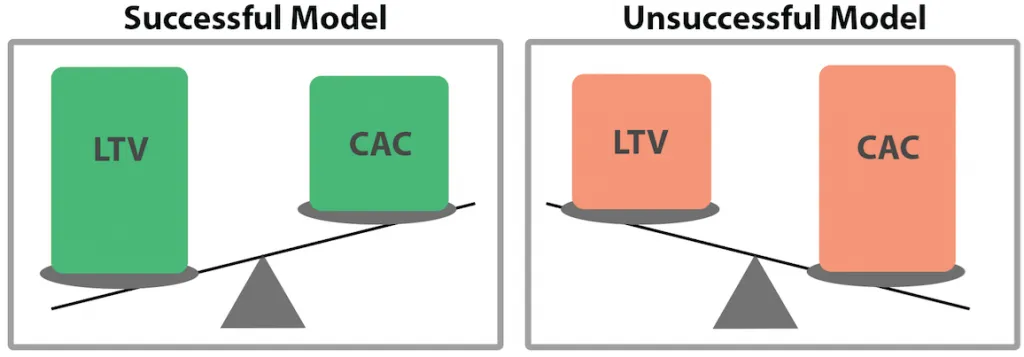
For example, if you spend $200 to acquire one new customer, and they only pay for one month’s subscription ($50) before cancelling, you’re left with a loss of $150.
While this ratio applies to every business, it becomes especially important for subscription services when they must explicitly keep subscriptions active in order to know that LTV is increasing.
What should your LTV:CAC ratio be?
The benchmark for the LTV:CAC ratio is 3:1. This means that if you spend $100 to acquire a new customer, you should retain them at least long enough for them to contribute $300 to your business.
It’s not uncommon for SaaS companies to take 12 months to earn back CAC. However, the timeline isn’t as important as your ability to achieve it.

For more details on the LTV:CAC ratio, check out this post by ProfitWell.
What’s the reason for higher acquisition costs?
We mentioned that the LTV:CAC ratio is important because it’s normal for subscription services to spend a lot to acquire a customer. However, if the CAC for every subscription business was $0.10 then this wouldn’t even be a topic of conversation.
For context, it’s been cited that the difference of CAC between retail and software industries is $385 - $10 for retail and $395 for software. For subscription boxes like Blue Apron, CAC is upwards of $100.
Higher acquisition costs are a result of what the business model demands. You’re asking customers for a recurring purchase -- a commitment to spend the same amount (if not more) every month, rather than just $10 “here and there”.
But, it’s also the reason why it’s worth spending on acquisition because your recurring revenue determines your growth. it makes more sense to go to greater lengths to lock someone into a predictable revenue cycle.
Although it’s expensive, acquisition is the “easy” part. Who wouldn’t want to take advantage of a free trial or free delivery? This leads us to the ultimate question -- how do you turn one-time users into long-time subscribers?
The most important thing for your subscription's loyalty strategy to focus on
How do you guarantee those repeat purchases, and prevent subscribers from canceling to hop to the next best service? In other words, how do you build customer loyalty as a subscription service?
The answer is in focusing on reinforcing the right parts of the customer lifecycle -- the parts that present your best opportunity of converting “users” to paid subscribers.
To start, let’s lay out what the ideal customer journey looks like for a subscription service (or any other company):
(for a refresher on the customer lifecycle, check out this article)

But the reality for so many subscription companies looks like this:
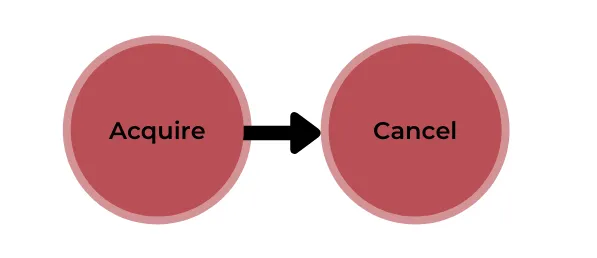
What is going wrong?
While acquisition is important and necessary, it’s where a lot of subscription companies put the brakes on loyalty initiatives. They pile on the acquisition strategies, from influencer programs and affiliate marketing to welcome bonuses and free trials, assuming that acquisition is synonymous with retention.
As a result, metrics “look” great, and subscriber growth “looks” great. Investors are happy with subscriber counts. Customers are happy with free samples.
But in reality, the excitement of acquisition (ie. getting things for free) wears off and customers aren’t presented with a good enough reason to continue their subscription. What happens is that customers cancel before their LTV can exceed CAC, so companies try to backfill what they just lost with more acquisition efforts and new-user rewards.
While this may appear to work, it doesn’t yield profit in the long run.
What’s missing is the critical step of proving to customers that you are worth their financial commitment, and that your product's continuous deliveries or access will significantly improve their quality of life: the Activation stage.
The solution: An activation-focused approach
The most important customer lifecycle stage for a subscription service to master is Activation -- the stage immediately following acquisition.
Activation signifies the moment when a user first understands the value of your product. For a subscription service, this is typically during a free trial or limited access period before any financial commitment is made.
A customer is considered “activated” when they try out your service enough to realize the true usefulness, joy or value of it - this is often referred to as the customer’s “aha” moment or “activation event”, which we’ll discuss shortly.
This means that having a user sign up for a trial or receive one free delivery in the acquisition stage isn’t enough. If a user doesn’t use your product and experience it for the correct amount of time, and in the right ways, they will likely never buy.
Just like how you probably won’t commit to marrying someone after meeting for the first time, you need to spend time getting to know a product until you’re ready to lock in a recurring payment.
Here are a few examples to illustrate activation:
- The value of a meal-kit delivery service won't be obvious until it's incorporated into someone's weekly routine, clearly saving them trips to the grocery store.
- A music-streaming service's benefits won't be fully apparent until the listener has had the opportunity to make playlists, download songs for offline use, and discover a new artist.
- The employee using new help-desk software won't see it as a viable expense until they have read the help documentation, customized their company's help center, and resolved client issues with it.
It all comes down to encouraging users to incorporate your product into their routines and turn it into a habit - not be something they question after looking at their credit card bill each month. They must realize that they are better off with the service rather than without it.
And if it takes us more than 2 months to form new habits in our own lives, you can't always expect a customer to be hooked after just one use.
How do you "Activate" a customer?
A successful customer activation starts with understanding your product’s unique activation event.
As we cover in the Digital Loyalty Academy, an activation event is a customer action that, when completed, typically leads to product or service adoption. For example, Dropbox will encourage you to upload a file when you sign up, and Twitter will encourage you to find people/topics to follow.
Learning your activation event involves looking at past data to uncover what actions, journeys or timelines are most likely to develop committed customers. It's usually a combination of performing some specific action (ie. placing orders, using the app) over a sufficient period of time.
Supercharging your activation event means encouraging customers to complete or reach it in exchange for loyalty rewards. Offering rewards like free shipping, credit towards a future purchase, or a free gift after 3 months helps encourage users to extend their subscription to the activation point, or guide them to explore the most valuable parts of the service.
Is Activation really "more important" than acquisition and retention?
What we hope you learned reading this article so far is that subscription services must understand the importance of successfully moving new users through the activation stage. The acquisition and retention stages also require a business's attention and resources, and are not meant to be deemed any less important. However, without successful activation, the rest of the stages become irrelevant:
- If you're successful at acquiring customers, but can't activate them, you will not turn any users into paying subscribers
- If you're not successful at activating customers, you won't have any paying subscribers to retain anyway
Further Reading:
- Why activation is the most important pirate metric for SaaS growth
- The problem with acquisition-based growth (and what to do instead)
To put this together with the rest of the customer lifecycle, we've summarized each lifecycle stage below plus the associated risks for a subscription business (red = high risk, yellow = lower risk). As you can see, activation represents the most typical drop-off point, making it the most important stage to reinforce with loyalty incentives.
| Customer Lifecycle Stage | Customer action at this stage: Delivery (ie. Dollar Shave Club) | Customer action at this stage: Software/Access (ie. Spotify) | Business risks at this stage |
| Acquisition | Orders first box (likely at discounted rate) | Signs up for a free trial | Company is burning through marketing budget too quickly with acquisition offers |
| Activation | Realizes benefit of incorporating deliveries into regular routine | Realize value added to personal or professional life | Acquisition offer wears off, customer sees no reason to pay for subscription |
| Revenue (optimization) | Upgrades plan, places larger or more frequent orders | Upgrades to paid/higher-tier plan | Customer cancels or downgrades and LTV comes to a halt (or lowers) |
| Retention | Customer cancels and is (ideally) reactivated | Customer cancels/downgrades and is (ideally) reactivated to paid | Cancelled customer sees no good enough reason to re-activate subscription |
| Referral | Refers new friends | Refers new friends | Business is unable to leverage this cost-effective acquisition method |
A complete lifecycle approach to loyalty
Being conscious of the importance of the activation stage lets you create a more effective customer loyalty strategy across the entire lifecycle. Here's how loyalty incentives can come together to create a complete growth strategy for subscriptions.
For a more in-depth example, check out exactly what we recommended for Blue Apron’s loyalty program.
Acquisition
Since subscription profit depends on recurring revenue, but the risk of commitment must be mitigated for the customer, acquisition offers are a great way to get customers interested.
Remember that with the customer lifecycle mode we’re using, Acquisition does not usually mean payment, but rather acquisition of customer information.
Suggested Campaign: Welcome Offer
Many SaaS products leverage free trial periods, or discounted deliveries before a full payment is required.
A popular tactic for delivery-based subscriptions is to segment welcome offers geographically. This helps accelerate growth in new areas or hold off competitors.
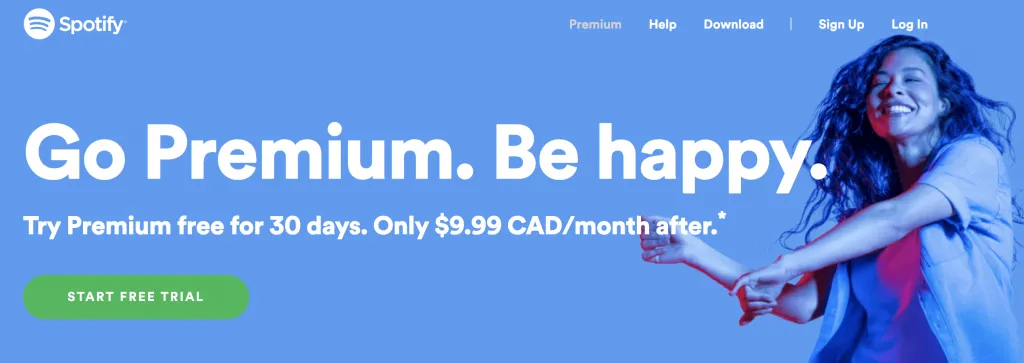
Activation
For a subscription service, activation directly determines revenue. If you can’t make users see the value in using your service, no one will pay for it.
It’s during the activation stage where you pull out all the stops to demonstrate this value - leverage data to personalize offerings, suggest relevant subscription plans, and let users become more invested in the product.
Suggested Campaign: Activation offer
Reward customers for keeping their trial or subscription active long enough to pass your activation point. For example, let customers earn a free delivery after their 5th box, or reward with credit when they complete their profile, use an in-app feature, or watch a tutorial.
Dropbox does a great job at influencing new users to become invested in the application, offering a storage bonus for completing specific activation events:
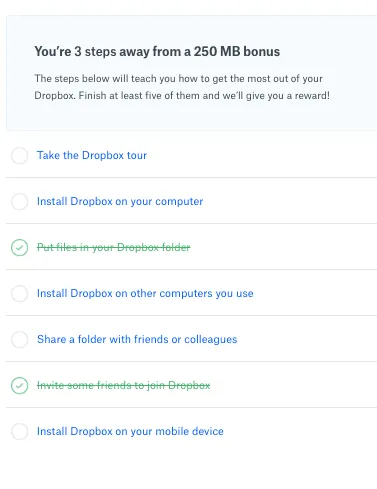
Once a user has installed Dropbox on their devices, uploaded files, and learned how to make the most of the application, they are now set up to start using it in everyday life, and are less likely to switch to a competitor to do it all over again.
Revenue (optimization)
Once a customer has been activated, they understand the value of paying for your service on a repeat basis. But how do you convince them that their money isn’t better spent with a competitor?
By leveraging the power of FOMO and loyalty rewards, you can convince the customer that they will be worse off if they cancel their subscription, either because they will lose special access, or have to give up VIP customer status and points that they have worked hard to collect. These rewards should be in addition to the inherent value provided by your base product offering.
Suggested Campaign: VIP rewards
VIP programs are excellent at increasing switching costs and getting customers more invested in your brand community. Reward continued purchases and upsells with points, exclusive deals with third-party partners, access to sales, and new releases. You make it difficult for customers to cancel a subscription when it’s clear how much they will be losing out on.
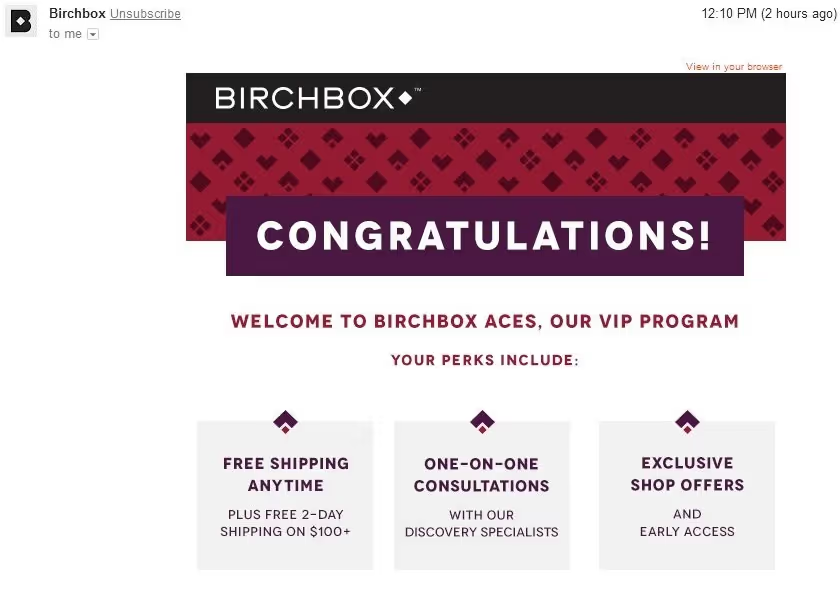
Retention
While a customer’s lifetime value comes to a halt when they cancel, there’s no reason for this to be permanent! You still have a 60-70% chance of success to sell to them again, whereas this success rate drops to 5-20% for brand new customers.
It may seem tempting to go straight back to the acquisition stage, but remember that profit is a result of each customer’s LTV exceeding CAC -- much easier to do with an existing customer for whom you don’t need to spend money acquiring again.
Suggested Campaign: Win Back Offer
Offering an incentive for re-activation may be just what a past subscriber needs to check out your new and improved offerings. For more tips on running a win-back campaign, check out this article.
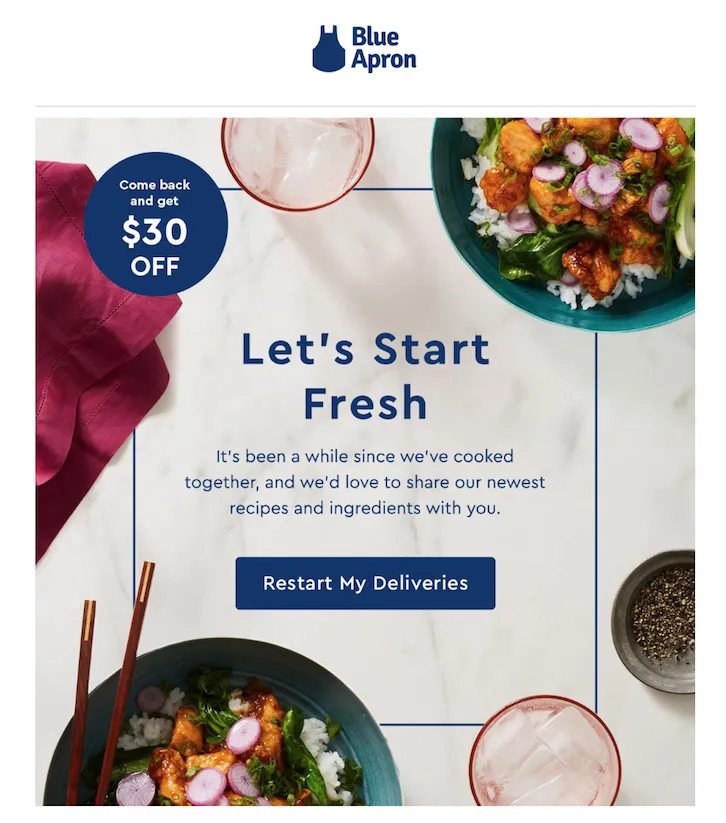
Referral
Surveys reveal that 83% of consumers are willing to refer after a positive experience—yet only 29% actually do. Give your loyal customers the opportunity to invite friends to try your service and develop into strong brand advocates.
Suggested Campaign: Customer referral program
We recommend double-sided referral programs to fully leverage the principle of reciprocity. Some examples include:
- “Give $10 get $10 when you invite a friend”
- “Refer a friend and get free shipping on your next delivery”
Download our free guide to customer referral programs here.
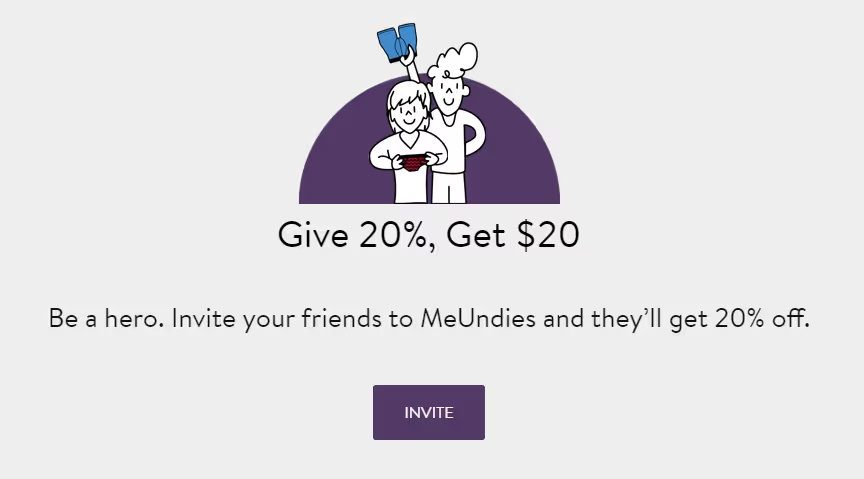
Final Thoughts
No matter how well you can acquire customers, each user needs a good reason to keep moving through the lifecycle, get more deeply engaged, and incorporate your subscription into their lives.
If you ignore the parts of the lifecycle that actually drive subscriber commitment, you'll have a hard time seeing profit.
What kind of business do you want to see us breakdown a loyalty strategy for next? Tweet us and let us know!